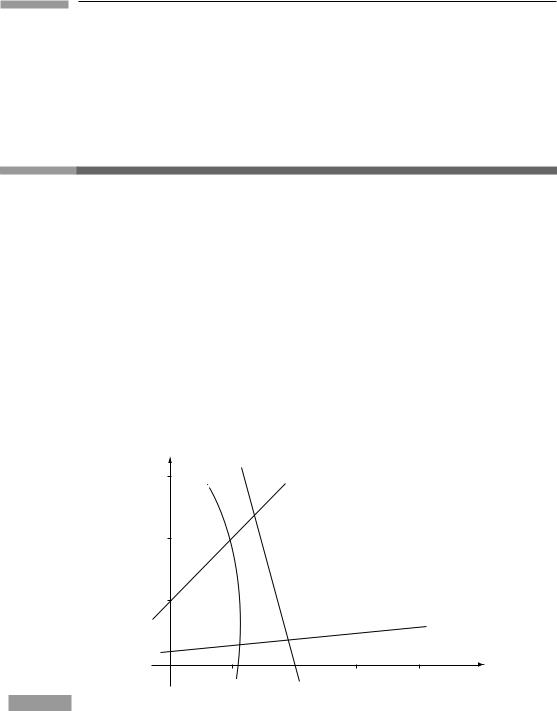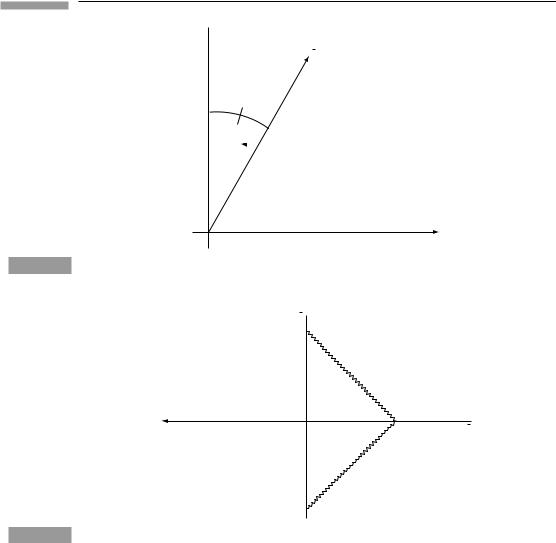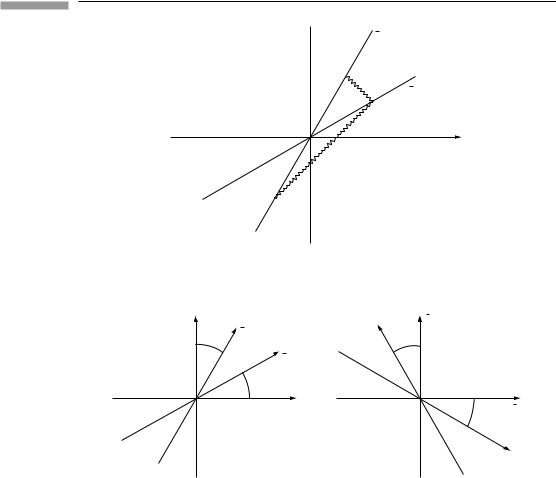
- •Contents
- •Preface to the second edition
- •Preface to the first edition
- •1 Special relativity
- •1.2 Definition of an inertial observer in SR
- •1.4 Spacetime diagrams
- •1.6 Invariance of the interval
- •1.8 Particularly important results
- •Time dilation
- •Lorentz contraction
- •Conventions
- •Failure of relativity?
- •1.9 The Lorentz transformation
- •1.11 Paradoxes and physical intuition
- •The problem
- •Brief solution
- •2 Vector analysis in special relativity
- •Transformation of basis vectors
- •Inverse transformations
- •2.3 The four-velocity
- •2.4 The four-momentum
- •Conservation of four-momentum
- •Scalar product of two vectors
- •Four-velocity and acceleration as derivatives
- •Energy and momentum
- •2.7 Photons
- •No four-velocity
- •Four-momentum
- •Zero rest-mass particles
- •3 Tensor analysis in special relativity
- •Components of a tensor
- •General properties
- •Notation for derivatives
- •Components
- •Symmetries
- •Circular reasoning?
- •Mixed components of metric
- •Metric and nonmetric vector algebras
- •3.10 Exercises
- •4 Perfect fluids in special relativity
- •The number density n
- •The flux across a surface
- •Number density as a timelike flux
- •The flux across the surface
- •4.4 Dust again: the stress–energy tensor
- •Energy density
- •4.5 General fluids
- •Definition of macroscopic quantities
- •First law of thermodynamics
- •The general stress–energy tensor
- •The spatial components of T, T ij
- •Conservation of energy–momentum
- •Conservation of particles
- •No heat conduction
- •No viscosity
- •Form of T
- •The conservation laws
- •4.8 Gauss’ law
- •4.10 Exercises
- •5 Preface to curvature
- •The gravitational redshift experiment
- •Nonexistence of a Lorentz frame at rest on Earth
- •The principle of equivalence
- •The redshift experiment again
- •Local inertial frames
- •Tidal forces
- •The role of curvature
- •Metric tensor
- •5.3 Tensor calculus in polar coordinates
- •Derivatives of basis vectors
- •Derivatives of general vectors
- •The covariant derivative
- •Divergence and Laplacian
- •5.4 Christoffel symbols and the metric
- •Calculating the Christoffel symbols from the metric
- •5.5 Noncoordinate bases
- •Polar coordinate basis
- •Polar unit basis
- •General remarks on noncoordinate bases
- •Noncoordinate bases in this book
- •5.8 Exercises
- •6 Curved manifolds
- •Differential structure
- •Proof of the local-flatness theorem
- •Geodesics
- •6.5 The curvature tensor
- •Geodesic deviation
- •The Ricci tensor
- •The Einstein tensor
- •6.7 Curvature in perspective
- •7 Physics in a curved spacetime
- •7.2 Physics in slightly curved spacetimes
- •7.3 Curved intuition
- •7.6 Exercises
- •8 The Einstein field equations
- •Geometrized units
- •8.2 Einstein’s equations
- •8.3 Einstein’s equations for weak gravitational fields
- •Nearly Lorentz coordinate systems
- •Gauge transformations
- •Riemann tensor
- •Weak-field Einstein equations
- •Newtonian limit
- •The far field of stationary relativistic sources
- •Definition of the mass of a relativistic body
- •8.5 Further reading
- •9 Gravitational radiation
- •The effect of waves on free particles
- •Measuring the stretching of space
- •Polarization of gravitational waves
- •An exact plane wave
- •9.2 The detection of gravitational waves
- •General considerations
- •Measuring distances with light
- •Beam detectors
- •Interferometer observations
- •9.3 The generation of gravitational waves
- •Simple estimates
- •Slow motion wave generation
- •Exact solution of the wave equation
- •Preview
- •Energy lost by a radiating system
- •Overview
- •Binary systems
- •Spinning neutron stars
- •9.6 Further reading
- •10 Spherical solutions for stars
- •The metric
- •Physical interpretation of metric terms
- •The Einstein tensor
- •Equation of state
- •Equations of motion
- •Einstein equations
- •Schwarzschild metric
- •Generality of the metric
- •10.5 The interior structure of the star
- •The structure of Newtonian stars
- •Buchdahl’s interior solution
- •10.7 Realistic stars and gravitational collapse
- •Buchdahl’s theorem
- •Quantum mechanical pressure
- •White dwarfs
- •Neutron stars
- •10.9 Exercises
- •11 Schwarzschild geometry and black holes
- •Black holes in Newtonian gravity
- •Conserved quantities
- •Perihelion shift
- •Post-Newtonian gravity
- •Gravitational deflection of light
- •Gravitational lensing
- •Coordinate singularities
- •Inside r = 2M
- •Coordinate systems
- •Kruskal–Szekeres coordinates
- •Formation of black holes in general
- •General properties of black holes
- •Kerr black hole
- •Dragging of inertial frames
- •Ergoregion
- •The Kerr horizon
- •Equatorial photon motion in the Kerr metric
- •The Penrose process
- •Supermassive black holes
- •Dynamical black holes
- •11.6 Further reading
- •12 Cosmology
- •The universe in the large
- •The cosmological arena
- •12.2 Cosmological kinematics: observing the expanding universe
- •Homogeneity and isotropy of the universe
- •Models of the universe: the cosmological principle
- •Cosmological metrics
- •Cosmological redshift as a distance measure
- •The universe is accelerating!
- •12.3 Cosmological dynamics: understanding the expanding universe
- •Critical density and the parameters of our universe
- •12.4 Physical cosmology: the evolution of the universe we observe
- •Dark matter and galaxy formation: the universe after decoupling
- •The early universe: fundamental physics meets cosmology
- •12.5 Further reading
- •Appendix A Summary of linear algebra
- •Vector space
- •References
- •Index

5 |
1.4 Spacetime diagrams |
The SI units contain many ‘derived’ units, such as joules and newtons, which are defined in terms of the basic three: m, s, kg. By converting from s to m these units simplify considerably: energy and momentum are measured in kg, acceleration in m−1, force in kg m−1, etc. Do the exercises on this. With practice, these units will seem as natural to you as they do to most modern theoretical physicists.
1.4 S p a ce t i m e d i a g ra m s
A very important part of learning the geometrical approach to SR is mastering the spacetime diagram. In the rest of this chapter we will derive SR from its postulates by using spacetime diagrams, because they provide a very powerful guide for threading our way among the many pitfalls SR presents to the beginner. Fig. 1.1 below shows a twodimensional slice of spacetime, the t − x plane, in which are illustrated the basic concepts. A single point in this space5 is a point of fixed x and fixed t, and is called an event. A line in the space gives a relation x = x(t), and so can represent the position of a particle at different times. This is called the particle’s world line. Its slope is related to its velocity,
slope = d t/dx = 1/v.
Notice that a light ray (photon) always travels on a 45◦ line in this diagram.
Figure 1.1
t
(m)
Accelerated
world line
World line of light, v = 1
World line of particle moving at speed |v| < 1
 An event
An event
World |
line |
with |
velocity |
v>1 |
|
||||
|
|
|||
|
|
|
||
|
|
|
|
x (m)
A spacetime diagram in natural units.
5We use the word ‘space’ in a more general way than you may be used to. We do not mean a Euclidean space in which Euclidean distances are necessarily physically meaningful. Rather, we mean just that it is a set of points that is continuous (rather than discrete, as a lattice is). This is the first example of what we will define in Ch. 5
to be a ‘manifold’.

6 |
Special relativity |
We shall adopt the following notational conventions:
(1) |
Events will be denoted by cursive capitals, e.g. A, B, P. However, the letter O is |
|||
|
reserved to denote observers. |
|
|
|
(2) |
The coordinates will |
be |
called |
(t, x, y, z). Any quadruple of numbers like |
|
(5, −3, 2, 1016) denotes |
an |
event |
whose coordinates are t = 5, x = −3, y = 2, |
z = 1016. Thus, we always put t first. All coordinates are measured in meters.
(3)It is often convenient to refer to the coordinates (t, x, y, z) as a whole, or to each indifferently. That is why we give them the alternative names (x0, x1, x2, x3). These superscripts are not exponents, but just labels, called indices. Thus (x3)2 denotes the square of coordinate 3 (which is z), not the square of the cube of x. Generically, the coordinates x0, x1, x2, and x3 are referred to as xα . A Greek index (e.g. α, β, μ, ν) will be assumed to take a value from the set (0, 1, 2, 3). If α is not given a value, then xα is any of the four coordinates.
(4)There are occasions when we want to distinguish between t on the one hand and (x, y, z) on the other. We use Latin indices to refer to the spatial coordinates alone. Thus a Latin index (e.g. a, b, i, j, k, l) will be assumed to take a value from the set (1, 2, 3). If i is not given a value, then xi is any of the three spatial coordinates. Our
conventions on the use of Greek and Latin indices are by no means universally used by physicists. Some books reverse them, using Latin for {0, 1, 2, 3} and Greek for {1, 2, 3};
others use a, b, c, . . . for one set and i, j, k for the other. Students should always check the conventions used in the work they are reading.
1.5 Co n s t r u c t i o n o f t h e co o rd i n a t e s u s e d b y a n o t h e r o b s e r v e r
Since any observer is simply a coordinate system for spacetime, and since all observers look at the same events (the same spacetime), it should be possible to draw the coordinate lines of one observer on the spacetime diagram drawn by another observer. To do this we have to make use of the postulates of SR.
Suppose an observer O uses the coordinates t, x as above, and that another observer O¯ , with coordinates ¯t, x¯, is moving with velocity v in the x direction relative to O. Where do the coordinate axes for ¯t and x¯ go in the spacetime diagram of O?
¯t axis: This is the locus of events at constant x¯ = 0 (and y¯ = z¯ = 0, too, but we shall ignore them here), which is the locus of the origin of O¯ ’s spatial coordinates. This is O¯ ’s world line, and it looks like that shown in Fig. 1.2.
x¯ axis: To locate this we make a construction designed to determine the locus of events at ¯t = 0, i.e. those that O¯ measures to be simultaneous with the event ¯t = x¯ = 0.
Consider the picture in O¯ ’s spacetime diagram, shown in Fig. 1.3. The events on the x¯ axis all have the following property: A light ray emitted at event E from x¯ = 0 at, say, time ¯t = −a will reach the x¯ axis at x¯ = a (we call this event P); if reflected, it will return to the point x¯ = 0 at ¯t = +a, called event R. The x¯ axis can be defined, therefore, as the locus of

7
Figure 1.2
Figure 1.3
1.5 Construction of the coordinates used by another observer
t 
t
 Tangent of this angle is υ
Tangent of this angle is υ
x
The time-axis of a frame whose velocity is v.
t a
a x
–a
Light reflected at a, as measured by O¯ .
events that reflect light rays in such a manner that they return to the ¯t axis at +a if they left it at −a, for any a. Now look at this in the spacetime diagram of O, Fig. 1.4.
We know where the ¯t axis lies, since we constructed it in Fig. 1.2. The events of emission and reception, ¯t = −a and ¯t = +a, are shown in Fig. 1.4. Since a is arbitrary, it does not matter where along the negative ¯t axis we place event E, so no assumption need yet be made about the calibration of the ¯t axis relative to the t axis. All that matters for the moment is that the event R on the ¯t axis must be as far from the origin as event E. Having drawn them in Fig. 1.4, we next draw in the same light beam as before, emitted from E, and traveling on a 45◦ line in this diagram. The reflected light beam must arrive at R, so it is the 45◦ line with negative slope through R. The intersection of these two light beams must be the event of reflection P. This establishes the location of P in our diagram. The line joining it with the origin – the dashed line – must be the x¯ axis: it does

8 |
Special relativity |
t
t
a
x
x
|
|
–a |
|
|
|
|
|
The reflection in Fig. 1.3, as measured . |
Figure 1.4 |
||
|
|
O |
t |
t |
|
t |
t |
|
φ |
|
φ |
|
||
|
|
|
|
||
|
|
x |
|
|
|
|
|
φ |
|
|
|
|
|
x |
|
φ |
x |
|
|
|
|
||
|
|
|
|
|
x |
(a) |
|
|
|
(b) |
|
Figure 1.5 |
Spacetime diagrams of O (left) and O¯ (right). |
not coincide with the x axis. If you compare this diagram with the previous one, you will see why: in both diagrams light moves on a 45◦ line, while the t and ¯t axes change slope from one diagram to the other. This is the embodiment of the second fundamental postulate of SR: that the light beam in question has speed c = 1 (and hence slope = 1) with respect to every observer. When we apply this to these geometrical constructions we immediately find that the events simultaneous to O¯ (the line ¯t = 0, his x axis) are not simultaneous to O (are not parallel to the line t = 0, the x axis). This failure of simultaneity is inescapable.
The following diagrams (Fig. 1.5) represent the same physical situation. The one on the left is the spacetime diagram O, in which O¯ moves to the right. The one on the right is drawn from the point of view of O¯ , in which O moves to the left. The four angles are all equal to arc tan |v|, where |v| is the relative speed of O and O¯ .
